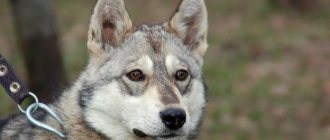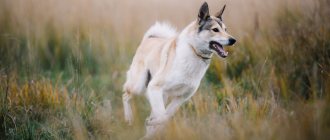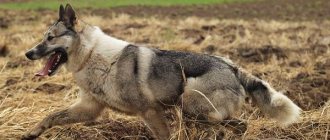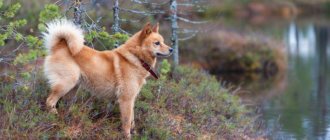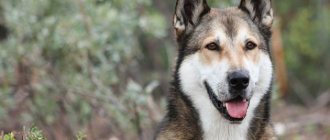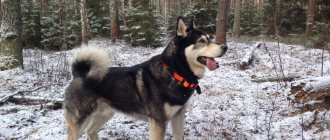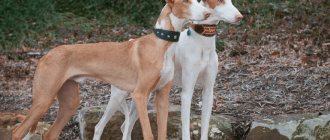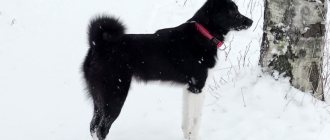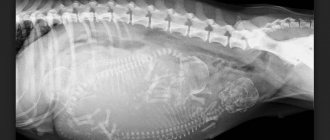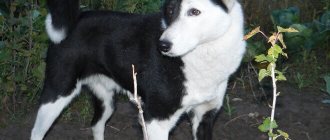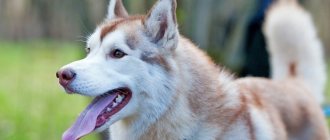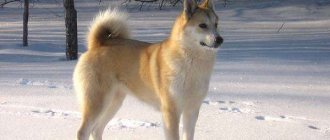Types of huskies
Now it’s worth talking about the types of huskies that exist.
West Siberian
The height at the withers should be 55–62 cm for males and 51–58 cm for females.
Representatives of this group have average or above average height. They are distinguished by a strong and strong physique. According to the standard, the length of the body from the shoulder-scapula joint to the ischial tuberosities should not be much greater than the height at the withers.
West Siberian huskies have pronounced sexual dimorphism, males are larger than females and look more masculine. Both have well-developed muscles and strong skeletal bones.
Among the suits allowed according to the standard are the following:
- gray-zonal;
- red-zoned;
- gray;
- redhead;
- fawn;
- red-brown of any shade.
It is acceptable to have a white suit or piebald. On the white coat there are spots of any color than those listed in the list.
Russian-European Laikas
According to the standard, the height of males at the withers is 52 - 58 cm, females 48 - 54 cm. The dogs are medium in size, strong in build and have a square body. The length of the body can exceed the height at the withers. Representatives of the breed have strong bones and well-developed dry muscles. Just like the previous species, sexual dimorphism is developed.
Among the acceptable suits typical for the group:
- black with white;
- white with black;
- pure black;
- pure white.
East Siberian Laika
The height at the withers is 57–64 cm for males and 53–60 cm for females.
Representatives of the group are of medium size and have a compact but strong build. The head size is quite large. Males have stronger bones than females. Females, like males, have well-developed muscles.
Acceptable suits include:
- black with tan markings of red color;
- black;
- black with white;
- gray;
- redhead;
- brown;
- zonal;
- fawn;
- white;
- spotted with all the colors listed above.
According to the standard, the paws may have a small number of specks of the same color as the main color.
Representatives of the species are distinguished by a remarkable indicative reaction and an excellent sense of smell. Such a dog shows excellent hunting qualities, especially for large animals. The dog works best on its own. Laikas have a good disposition and are trusting of people.
Bear Karelian Laika
The standard established for males the height at the withers is 57 cm, for females 52 cm, a variation of 3 cm is allowed both in greater and lesser directions. In weight, males can reach 25–28 kg, females 17–20 kg. The dogs are medium in size and have a strong and robust build. The coat is thick.
Moose Norwegian Husky
According to the standard, a male must have a height at the withers of 52 cm, and a female 49 cm. The appearance is typical for all huskies. The body is compact and short, the cervical region is flexible and has the correct position. The coat is thick and abundant, but not harsh or too long. The tail is wrapped in a tight ring lying on the back.
Finnish Spitz (Finnish Laika)
The breed standard established the height at the withers for males is 47 cm, for females 42 cm. A deviation of 3 cm upwards and downwards is acceptable.
The height is below average, the body is square-shaped, while it is strong and dry. This variety is suitable for hunting birds of the grouse family, small predatory animals, waterfowl and elk.
Appearance and character traits of ZSL
This breed standard was approved on 03/02/2011. According to this standard, the West Siberian Laika is assigned the number 306 . The dog belongs to group No. 5 - Spitz and primitive types of dogs, to section 1.1 - northern hunting dogs. A purebred representative of an SSL must have the following qualities:
- important proportions: the ratio of body length to height at the withers is 100/103:107 in males, 100/104:108 in females;
- the length of the head is significantly greater than its width;
- the height at the withers exceeds the height at the rump by 1–2 cm in males and is equal to or exceeds by 1 cm in females;
- the length of the muzzle is equal to or slightly less than 1/2 the length of the head;
- The length of the forelimbs is slightly more than 1/2 the height at the withers.
- dark brown;
- straight, parallel;
- muscular, straight, parallel;
- dense, thick, rough and straight;
- zonal gray;
- male - 55–62 cm;
The hair of the West Siberian Laika is longer in the neck area than along the body, so it forms a kind of collar
In ZSL, there is a pronounced difference between males and females—sexual dimorphism. So, males are larger and more muscular. They have expressive withers and a wide back.
Difference between Mansi and Khanty type
Today it is customary to divide the WSL into pets of the Mansi and Khanty types. Each of these types has its own distinctive features.
Representatives of the Mansi type are taller and thinner and have the following characteristics:
- narrow, deep chest;
- high neck;
- “hare’s” foot (more elongated);
- pointed head;
- big ears;
- round eyes;
- smooth coat.
West Siberian huskies of the Mansi type are thinner and taller
The long-legged husky can easily track game in the impenetrable taiga.
The Khanty type Laika is more massive, has a stretched body and is distinguished by:
- wide chest;
- low-set neck;
- "cat's" paw (rounded);
- large skull;
- small muzzle;
- small ears;
- almond-shaped eyes;
- standing wool;
- abundant undercoat;
- expressive collar and sideburns.
The Khanty-type ZSL has almond-shaped eyes and small ears
The Khanty-type Laika tolerates low temperatures well, so it easily adapts to the extremely low temperatures of the northern regions.
Ideally, a purebred West Siberian Laika should have the best characteristics of both types.
Character of ZSL
ZSL are balanced and patient pets. But at the same time they are very active and mobile. Dogs are excellent for hunting any animal, as they are well oriented in space and have high intelligence. The pet's guard qualities are poorly developed. Laikas are friendly towards people and other dogs, as well as pets, but when danger arises they can behave aggressively and unrestrainedly. Laikas are ready to pursue wild animals and pets unfamiliar to them with particular cruelty.
ZSL can easily track animals moving along the treetops.
Laikas can play both the role of a hunter and a companion. They get along well with children.
A loud bark is another distinctive feature of huskies.
ZSL are independent pets, but do not strive for dominance and power.
Nicknames for girls and boys
Once you have decided on a dog, it is important to give your puppy a name. It should reflect his character, be sonorous, and easy to remember
First of all, you need to consider the gender of your animal. The most popular names for male West Siberian huskies are:
- Archie;
- Alex;
- Alf;
- Ars;
- Azor;
- Eurek;
- Joy;
- Gray;
- Jean;
- Eli;
- Michael;
- Marseilles;
- Newton;
- Teddy;
- Theodore;
- Stan;
- Charlie;
- Chico;
- Iago.
If you are the owner of a female, then one of these names may suit your pet:
- Alma;
- Alice;
- Anfisa;
- Vega;
- Sharing;
- Wanda;
- Yesya;
- Gretta;
- Judy;
- Kukki;
- Zeta;
- Indie;
- Laura;
- Lily;
- Paw;
- Miranda;
- Maxi;
- Maggie;
- Patricia;
- Puma;
- Puffy;
- Scarlett;
- Taystee;
- Ultra;
- Una;
- Chloe;
- Hayley;
- Chilita;
- Charlize;
- Yumi;
- Jadwiga.
You can choose your favorite nickname from the list provided or choose any other one you wish.
A story about the breed in the next video.
Description of the breed
The West Siberian Laika is considered a rather highly specialized breed. Initially, its direct purpose was hunting. Modern representatives of the West Siberian breed descended from huskies, which once lived in Siberia and the Urals. Accordingly, the dogs lived in rather unfavorable environmental conditions, and therefore they had to adapt to the harsh taiga climate.
However, puppies of the West Siberian breed, as we know it today, were not born naturally: they were specially bred thanks to the long and painstaking work of scientific breeders. This selection eliminated all weak individuals and those animals that had any (even the most minor) shortcomings. Today there are 2 varieties of the West Siberian Laika breed: Khanty and Mansi. These subspecies have both common features and some differences. So, for example, the Khanti husky has a more massive body, while the Manti animal has a completely different structure: a slimmer build and an elongated muzzle.
If we talk about the process of breeding the breed on the territory of our country, it should be said that selection dates back to the 20th century. It was during this period that the development of official standards for this breed also began. Such standards were adopted already in 1925
It is also important to note that over time, public interest in this breed is only growing, so the West Siberian Laika is becoming an increasingly popular and widespread breed
The anatomical structure of representatives of the West Siberian Laika breed has undergone standardization. For example, it is believed that a dog belonging to a given variety should have a head with a triangular outline. The skull is quite wide and the muzzle is elongated. Scissor bite. There are 2 types of eye shapes: almond and oval, the most common eye color is brown. The animal's ears, like its head, have a triangular shape and are erect. The stomach is quite elastic, and the chest is wide. The animal's paws are distinguished by their strength and power, and the dog's tail is shaped like a sickle. According to officially accepted standards, the height of the animal at the withers ranges from 50 to 80 cm. The hairline is quite short, but there is a thick undercoat.
In total, there are several possible colors of the West Siberian Laika in nature, namely:
- white-gray;
- gray with red;
- piebald;
- pale yellow.
Malformations of the breed
A defect in the development of a breed is interpreted in terms of the degree of its manifestation.
Flaws:
- slight sexual deformity;
- high excitability;
- Aquiline nose;
- light brown eyes;
- disturbance in the color of the nose and lips;
- absence of no more than 4 premolars;
- low-set ears;
- straightened shoulder-scapular joints; twisted elbows;
- flat ribs, shallow chest;
- flat or splayed paws;
- small spots on the head and limbs;
- sparse undercoat, brushes, muff, sideburns;
- restricted movements;
- height deviation is +2 cm in females, and -2 cm in males.
Vices:
- obesity or thinness;
- sudden stop;
- snub nose;
- short muzzle;
- saggy lips;
- violation of pigmentation of the nose, lips, eyelids;
- straight-set, round, bulging eyes;
- loose eyelids;
- the presence of not all teeth;
- small teeth;
- round, large ears;
- sagging or hunchbacked back;
- narrow, straight, sagging, hunchbacked or sunken lower back;
- small breasts;
- tail too short or too long;
- clubfoot;
- paws turned inward or outward;
- excessively pronounced or straightened angles of the hind limbs; twisted knees; cow or goat hind limbs;
- unnatural heavy gait;
- long curly coat;
- significant speckling of the same shade as the main color on the head and limbs, speckling on the body;
- specks of a different color than the main color;
- black or black and white color;
- deviation from standard height by more than 2 cm in either direction;
- The height at the withers is less than the height at the croup.
Disqualifying faults:
- high degree of aggressiveness and timidity;
- bite problems;
- distorted jaws;
- 4 or more missing teeth. Extra incisors;
- clouding of the cornea, eye color interspersed with a different color;
- hanging or semi-erect ears;
- short or straight tail;
- short-haired or long-haired;
- brown, blue, brindle colors.
Video: ZSL - universal hunter
Types and their characteristic differences
All dog breeds are divided according to different criteria for their purpose. There are service or guard ones. Laikas are considered sled dogs.
Since ancient times, sledding huskies have been used mainly in the far north for moving across snowy expanses and transporting goods.
Now, with the advent of new means of transportation, the need for them has decreased significantly, but they are still used in various competitions, as hunters and guards.
There are many breeds of sled huskies, but the most common are:
- samoyed huskies (samoyeds);
- Alaskan Malamute;
- Siberian sled dog (husky).
There are also Chukchi, Eskimo, and Kamchatka Laikas.
Samoyeds are very energetic, quite persistent and strong, of medium size, with a powerful head, dense and widely spaced ears.
They look like a fluff ball and are distinguished by densely growing fur. The legs and tail are strongly drooping. They are friendly, playful, easy to train, make good contact, and have a hard time parting with their owner.
Malamutes are widely used in Alaska not only for harnessing, but also for seal and bear hunting. Widespread in Russia.
They differ from Samoyeds in the proportionality of the head in relation to the body, a softer appearance, a large muzzle, medium ears, large paws, and a flat back. The tail is at a medium level, curls, but does not form a ring.
Most often this breed has a light gray color, white spots on the face, and a white tail in some places.
They are very kind by temperament, love attention, have well-developed muscles, are trainable, but sometimes have a stubborn character.
Huskies are very similar to Malamutes, only a little faster and are not able to carry large and heavy loads. They are distinguished by their gracefulness, narrower skull and canonical muzzle shape.
The ears are set high and directed forward. The eyes are either brown or blue, but can be a variety of colors. The color may be the same, but the husky is not as fluffy and weighs lighter than the malamute.
These dogs respond well to children, but require special care, attention and regular training.
Best articles: Fauna of Europe - list, names, characteristics and photos
Laika has long been used for hunting. Based on the character of a young dog, you can immediately determine who it will be as an adult.
Some immediately begin to hunt small game, others large animals. There are universal huskies that hunt both, but they are extremely rare.
They are taught to hunt small animals at the age of six months, and to hunt large animals from the age of 2 years.
A real animal husky will not be distracted by birds and small fur-bearing animals, but will direct all its attention to large prey. He orients himself well around the area and will never lose his owner in the taiga. Distinctive features of the beast husky:
Distinctive features of the beast husky:
- large growth;
- fast run;
- endurance;
- powerful voice;
- good sense of smell;
- passion for hunting.
To summarize, it is important to understand that the Laika is a breed of dog that requires a lot of attention, time, responsibility, physical and material costs. The future owner must calculate his capabilities for its maintenance and proper care. The future owner must calculate his capabilities for its maintenance and proper care
The future owner must calculate his capabilities for its maintenance and proper care.
By qualitatively fulfilling all the living conditions for a Laika, he will receive not only an assistant in his business, but a devoted friend for many years of life together.
Education and training
The West Siberian Laika has very friendly feelings towards its owner, so it accepts rules and restrictions without any problems. There are no problems with raising a husky puppy. Calmness and confidence are very important in learning; lessons are conducted without aggression .
Novash (Novas) Elena
Editor-in-Chief of the site, yoga instructor and big animal lover
Ask a Question
The hunting instincts of the husky cannot be suppressed even by the most severe training. She will always hunt, even if the owner is an animal rights activist. It makes no sense to punish or prohibit hunting.
A little husky needs socialization, getting to know the outside world, and developing the correct reaction to people, animals, and events. As soon as the quarantine ends after vaccinations, you need to start walking with the future hunter, communicating with other people, and learning simple commands.
The Laika was created for hunting, but in everyday life interaction with the dog is also necessary . It is necessary to learn the basic commands: “To me”, “You can’t”, “Place”, “Nearby”. This will make living together easier. You can accustom your baby to a collar as early as 3 months.
A course of OKD (general training course) would be useful for the West Siberian Laika to develop obedience.
It is better to conduct classes in nature, where the dog gets used to distractions. Positive motivation is important in learning, but you shouldn’t overdo it. There is no need to flirt with a working dog either.
Nataska
It is best to start training the West Siberian husky with a squirrel . In the hunt for this small animal, all the necessary qualities are developed: search, following, viscosity, voice. After successful work, the squirrel must be shot so that the husky can see the result of its work. The dog should not be allowed to tear the prey.
After the squirrel, you can begin training on other animals. Laika needs training on specific game. You can move on to the next animal only after successful training on the previous one.
It is advisable to conduct training in pairs with a more experienced husky, who will set an example with her actions and will not allow mistakes.
Preparation for hunting must begin at an early age:
- from 3 months – familiarization with the sight and smell of animals;
- from 5 months – training on small and medium-sized animals;
- from 7 months – baiting in the company of an experienced dog;
- from 2 years – training on large animals.
Let's summarize
We talked about two representatives of the Laika breed: West Siberian and Samoyed. Key aspects:
- The most popular among hunters is the West Siberian Laika.
- These dogs are hardy, unpretentious and not prone to diseases.
- How many years do West Siberian huskies live? They can live up to 17.5 years.
- Alas, Samoyed huskies, as a rule, do not live up to 14 years of age.
- They are prone to illness.
- Dogs really need human company and can be intrusive.
- They are suitable for keeping in an apartment, but their barking can drive anyone crazy.
- Samoyed huskies bark constantly, for any reason.
- Both breeds are not fussy about maintenance and care. Except that Samoyed huskies need regular check-ups with a veterinarian.
- It is advisable to feed dogs natural food. The basis of the diet is meat and cereals.
Origin of the breed and purpose
The origin stories of the two types of breed are somewhat different from each other. But there is one common point: a person needed a good working dog, hunter, assistant and friend, adapted to the difficult conditions of constant cold. And he managed to bring this out. Hunters value the husky for its tirelessness, adaptability to various climatic conditions, and its ability to navigate and find its way very successfully. They go with it to hunt fur-bearing animals, ungulates, wild boars and even bears. By the way, it is Siberian huskies that are adapted for hunting and give prey to humans, unlike, for example, huskies.
East Siberian Laika
This breed is proud of its Evenki and Tungus roots, because the ancestors of the Laika were these helper dogs, which for centuries accompanied people on hunts and transported cargo across snowy expanses. Before a certain unity of appearance became necessary, breeders cared only about enhancing the dog's hunting qualities. Over time, after the Great Patriotic War, the idea arose of creating nurseries for the purpose of studying and breeding the East Siberian Laika.
The breeding center was the Soviet Irkutsk, in 1980 the breed was recognized by the International Canine Federation, and nine years later the breed standard was drawn up and finally approved. Unfortunately, with the collapse of the Union, the nurseries also collapsed, most of the animals ended up in China, and there was no one else to monitor the purity of the breed. It is still a great success to meet a real purebred East Siberian Laika.
Hunting dogs also include the following breeds: Spaniel, Basset Hound, Beagle, Bloodhound, Drathaar, Weimaraner, Irish Setter, Shorthaired Pointer, and Fox Terrier
Important! Even within breed standards, dogs can have different types. This is due to the fact that breeders bring stud dogs from various regions of the country.
West Siberian Laika
The taiga husky has also come a long way towards its perfection. The harsh Siberian and Ural people did not spare weak dogs, loading everyone with the work necessary for survival. The strongest individuals survived and provided the basis for the future breed. The modern West Siberian Laika was created on the basis of the Khanty and Manti dogs. At first, the local population bred the breed for their own needs; from the early twenties of the last century, breeders became involved and undertook to bring the breed to a general standard of exterior and qualities.
The unique hunting skills of the dog were used during the Great Patriotic War, when they transported cargo and facilitated the work of people in subversive activities. After the war, nurseries began to appear, and in the 1980s, like the East Siberian, West Siberian Laika (pictured) was recognized as an independent breed by the International Canine Federation. However, the breed standard was fully approved only in 1996. You will not see the Western Husky in a harness; they are intended only for chasing prey.
How the breed appeared
The West Siberian Laika (WSL) is a Russian hunting dog breed, the history of which begins at the beginning of the 20th century. Its homeland is considered to be the forest regions of the Urals and the taiga territories of Siberia. The ancestors of these dogs are Mansi and Khanty Laikas.
Until the beginning of the 20th century, there were a large number of different varieties of huskies, each of which was unique in its own way. But some varieties still had dominant positions. For example, Manty and Khanty Laikas. Since in those days no attention was paid to the division into intra-breed types, chaotic crossing of huskies of all varieties took place. Based on this, dog experts concluded that the blood of Zyryan, Ural, Udmurd, Evenki, Lamuk, and German Laikas also flows in the ZSL. In addition, huskies were crossed with German shepherds and with the wild dog dingo.
ZSL is a young dog breed
For the first time, the question of identifying subspecies of huskies was raised at the World Canine Meeting in 1939. Among the main five subspecies, the Mansi and Khanty Laikas were named. In 1947, Soviet dog handler E.I. Shereshevsky proposed a new classification of huskies, according to which the Manty and Khanty pets were combined into one group - the West Siberian - ZSL.
In 1954, the ZSL breed standard was approved.
In 1980, the West Siberian Laika was recognized by the Fédération Cynologique Internationale (FCI).
Health
East Siberian huskies are distinguished by good health. The average life expectancy is 10-12 years, but there have been cases of longevity. Many dogs, with proper care and proper exercise, can live 14-15 years, remaining in excellent working shape.
Diseases
Laikas are not susceptible to genetic pathologies. But they are characterized by diseases associated with hunting activities:
- Leptospirosis. While walking or while hunting, a dog can eat a mouse and become infected with this disease. Or be bitten by a marten or weasel, which can also cause infection.
- Esophageal worms. While hunting, the East Siberian husky can catch and swallow a small rodent suffering from this infection. And thus she becomes infected.
- Snake bites. The viper is the enemy of huskies. Often the dog strives to enter into a fight with a dangerous opponent. A snake bite to the neck area is especially dangerous. The owner must have anti-snake serum with him. This will help save your pet from death.
Vaccinations
A healthy dog is the owner's concern. Carrying out routine mandatory vaccinations will protect your pet from dangerous fatal diseases, one of which is rabies. Owners of huskies are advised not to miss vaccination dates, as the dog is especially susceptible to diseases when in contact with wild animals. Before vaccinations, a number of preparatory measures must be taken:
- Expulsion of worms. Almost all puppies are infected with worms. Two weeks before the expected vaccination, dogs are given anthelmintics.
- Flea and tick treatment.
- A visit to a veterinarian who will give an opinion on your health status.
Complex vaccines allow you to simultaneously vaccinate your dog against a number of diseases. The Nobivak vaccine has proven itself well. The veterinarian selects an individual immunization schedule.
The standard schedule is:
- The first vaccination is at the age of 8-10 weeks. The dog is vaccinated against diseases such as canine distemper, adenovirus infection, parvovirus, parainfluenza.
- After 2 weeks, revaccination is performed.
- The third is after a complete change of teeth, usually at 6 months. The same vaccine is administered as at 8-10 weeks, plus anti-rabies serum is added.
- The next vaccination is at the age of 12 months. All previous vaccinations are completed.
Then the dog is vaccinated once a year for the rest of its life.
Buying a West Siberian Laika puppy
ZSL is a fairly common breed in Russia, and it is especially popular among hunters. Therefore, there should not be any problems with its acquisition. The cost of this dog is 5,000–20,000 rubles. Show dogs will cost more. But it is worth remembering that there is always a risk of running into unscrupulous sellers who are trying to sell low-quality “products”. In order not to become a victim of scammers and not to purchase an ordinary mongrel dog for a lot of money, you need to follow some tips:
- It is better to purchase a puppy from a nursery than from someone else;
- The optimal age of the puppy at the time of purchase is 3 months;
- the puppy should be moderately active and look healthy in appearance;
- puppies of three months of age already have the same breed characteristics as adult dogs, so you should focus on the generally accepted breed standard;
- You should not take the largest pet, as there is a high risk of obesity;
- you should inquire about the working qualities of the puppy’s parents;
- It’s worth finding out what kind of litter the female has and how often she gives birth. The best option is when the bitch gives birth once a year. Puppies from the first litter are considered weaker.
Puppies from the first litter are considered not entirely successful
Male puppies look impressive, but they are more independent and prone to running away. Females are flexible and easier to train. The only negative is estrus, which prevents normal hunting.
Buy | sell
| looking for a missing person Uryupinsk January 30, 2021 I ask for help in finding a West Siberian husky (female) of zone-red color, which disappeared on December 28, 2022 in the area of the Karaichevsky farm, Nekhaevsky district, ... |
| buyMoscowSeptember 7, 2020 Domestic mixed-breed puppies, 2 months old, g/w, different colors, will grow to be of medium size, very affectionate, cheerful and sociable, waiting for a reliable… |
| I'll give it to good hands Moscow August 25, 2020 Beautiful mixed-breed husky puppies, 2 months old, very smart, domestic, different colors: gray, black, black and white. Very good dogs for a family with… |
| 10 Belgorod8 February 2019 West Siberian Laika puppies, born 12/21/19, two boys and two girls |
| 5000 NovosibirskOctober 11, 2018 Selling West Siberian Laechkas. Purebred. Parents are workers. D. r. 09/04/2022. |
| 5000 Krasnodar25 April 2018 Laika puppies, born on March 13th. 1 boy left -5000?, and 3 girls -3000? . Parents with a passport. Mom is pure white. I'll give in!!! |
| 40000 January 17, 2018 I am selling a male West Siberian Laika, date of birth November 17, 2016, origin (Zyar VPKOS No. 1987/11 - Umka St No. 391-1631/LZS) Male with character, ... |
| I'll give it to good handsMoscowDecember 10, 2017 Our dear Linda looks a little like a cute fox with a neat face and house-like ears. Linda is a West Siberian Laika mix. Very devoted... |
| I'll give it to good hands Moscow November 25, 2017 We present to your attention a West Siberian husky mixed breed named Chuk. Our Chuk looks like both his mother Laika and a real gray wolf. Special charm... |
| 12000 September 18, 2017 West Siberian Laika puppies with pedigree for sale. There are 4 males and 1 female in the litter. Parents at field tests have diplomas in bear, badger, ... |
| Norilsk27 August 2017 Husky puppies for sale. The West Siberian Laika is a Russian breed of universal hunting dog. A dog of average and above average height, strong, dry... |
| 13000 May 20, 2017 West Siberian Laika puppies for sale from working studs with a pedigree. Born on April 18, 2022. There are 3 males in the litter. and 3 females. Father is a worker... |
| I'll give 100 to good handsMoscowApril 5, 2017 I will give into caring and loving hands a very active, intelligent, kind and affectionate girl, a West Siberian husky mix. Age 5 months. Bonya has been processed... |
| 20000 Murmansk February 27, 2017 I will sell puppies with a pedigree (stamp and metric of the puppy). Born January 13, 2022. Working parents (confirmed by diplomas). Call for details. |
| 12000 Krasnoyarsk February 6, 2017 West Siberian Laika puppies for sale. The parents are of high breed, have EXCELLENT exterior grades, diplomas in bear, boar, badger, and squirrel. ... |
| 15000 ShaturaDecember 20, 2016 1. Breed: ZSL 2. Number of puppies (males/females): 2/2 3. Date of birth of puppies: October 23, 2016 4. Color: male No. 1: gray-red with white male No. 2:… |
| 1000 mating Podolsk November 8, 2016 Male ZSL for mating in Podolsk, Moscow region. From working parents. Works properly on squirrels. We can take two or three puppies. |
| matingBryanskOctober 24, 2016 Male Trans-Siberian Laika, with pedigree, age 2 years. |
| 12000 October 13, 2016 Laika puppies for sale. Breed: West Siberian Laika Number of puppies in the litter (males/females): 3/3 Date of birth of puppies: September 6, 2016 Color:… |
| 10000 September 12, 2016 I will sell West Siberian Laika puppies from working parents. Date of birth 08/22/2016 Parents are commercial hunting dogs, they work in the taiga fur... |
| Istra12 July 2016 wonderful puppies with excellent pedigree from real hunters. boys and girls. Inexpensive. Born May 30, 2016 |
| 5000 Novomoskovsk16 May 2016 Zapodnosiberian Laika puppies mom and dad with documents |
| 10000 KrasnoyarskMay 2, 2016 I will sell LZS puppies from working fur dogs. The puppies were born on March 25th. There are 2 males and 2 females in the litter. |
| I'll give it to good hands Kazan April 19, 2016 We will give a West Siberian husky puppy to our home. she is 1.5 months old, very cute. . . . . it's hard for her in the apartment |
| 10000 Krasnoyarsk April 7, 2016 I will sell Laika puppies from working, purebred Laikas. Puppies were born on February 20, 2016. Parents in the taiga work on sable, elk, badger and wood grouse. For sale… |
| 4500 Ryazan April 3, 2016 Selling puppies from working parents. bargaining is appropriate |
| 20000 Lyubertsy2 March 2016 5 puppies for sale, gray red color. Distribution of puppies, February 19. Father of the puppies p.ch. Grip line p.p.p.p. Zuban Vronsky A.Yu. bitch then male p.p. Vagaya… |
| matingKirovFebruary 25, 2016 We offer West Siberian Laika, male, 3 years old. Thoroughbred, with documents. |
| 1000 February 10, 2016 I sell West Siberian Laika puppies, born November 10, 2015. Parents are workers (ungulates, fur). Two bitches left. 8 (960) 545-98-11(Margarita) |
| matingSochiJanuary 27, 2016 |
Best articles: Nocturnal animals - characteristics, origin, adaptations and examples
Sizes of huskies depending on species
All huskies are divided into several types depending on their working qualities, sizes, and colors. Some of them are still not even recognized by international organizations and are not exhibited at international shows.
The main branches of the breed are:
- East Siberian;
- West Siberian;
- Russian-European;
- Karelian-Finnish;
- Yakut;
- Karelian bear;
- Norwegian
The breed is very popular not only for its intelligence and devotion, but also for its ease of care. Representatives of the breed do not require expensive care, and at the same time they have a very beautiful fluffy coat with a dense undercoat.
East Siberian Laika
The largest and most versatile variety. A hunter to the very roots, he can hunt squirrels and bears. It features a large, powerful body. In height it reaches 53 – 65 cm at the withers.
Dogs are hardened by frost and can survive even in the harshest areas. They do not like the heat too much; it is better to provide an enclosure with a comfortable temperature. It is best to use a pet for its intended purpose. Such a husky is unlikely to become an unpretentious sofa dog.
West Siberian
The most common variety in hunting circles, and also numerous in number of types. The size of such a husky is not too large, the weight is on average 16 - 22 kg, and the height does not exceed 60 cm at the withers.
This dog is versatile in hunting and can be trained to hunt any game. The pet has a predatory exterior and looks more like a wolf than its other relatives. A distinctive feature is slanted, deep-set eyes.
Russian-European
A lean, light and muscular dog, an excellent hunter. Height at the withers is about 50-58 cm, weight does not exceed 25 kg. The physique and movements are graceful, very light. They require preliminary training to participate in hunting. They are capable of becoming excellent security guards in a private home.
Karelo-Finnish
The smallest variety of this breed. The weight of such a dog ranges from 7 to 12 kg. Height 42 – 50 kg. They hunt small fur-bearing animals, as well as small ungulates. The main difference from other varieties is the color of the dog - bright red, very juicy.
Yakut Laika
Refers to the type of traction dogs. At the moment it is not officially recognized by world organizations and does not have the right to participate in exhibition activities. However, connoisseurs of the breed still continue to breed these unusually beautiful and efficient animals. Their sizes range from 53 to 59 cm at the withers. They are distinguished by very fluffy wool with a dense undercoat.
Karelian Bear
The breed was bred in Finland for bear hunting. Externally, they can be confused with Russian-European representatives of the breed. The sizes are small, the weight of the dog ranges from 17 to 27 kg, and the height is about 52 to 57 cm. They have a very light, elegant, but powerful body.
Norwegian
One of the most ancient breeds, which has been used for centuries for moose hunting. There are two varieties of the breed: black and gray. Their differences lie in color. Otherwise, these are powerful and strong animals, reaching 47–52 cm at the withers, and growing in weight up to 25 kg. Can be used as herding dogs.
Laikas lived next to people for many years and helped them develop wild areas and territories. Today this function has faded away, but the instincts in these animals are still alive. Future owners of huskies need to think about whether they can provide active walking and long-term play for their pet.
Health
East Siberian huskies are quite strong animals. Most of their diseases are not genetic, but acquired.
To avoid many health problems, your puppy needs to be dewormed and vaccinated. The procedures are performed by a veterinarian at home or in a clinic
To monitor your puppy's development and weight gain, it is important to measure and weigh your pet.
Recommendations for vaccination:
- only a healthy dog, starting from 1.5 months of life, can be vaccinated;
- 1–2 weeks before the procedure it is necessary to rid the puppy of parasites;
- revaccination can be carried out only after 21 days;
- After vaccination, you must comply with the quarantine regime: the dog must not be bathed, overcooled, or allowed to come into contact with other animals or outdoor shoes.
The purpose of the described medical procedure is to protect the pet from common infectious diseases. Consult your veterinarian about which vaccine is best to use – imported or domestic.
Breeds similar to ZSL
The most similar breed is the East Siberian Laika, there are differences in the sizes and acceptable colors of the dogs, but at first glance it can be difficult to determine who is who.
ZSL VS VSL
Next, we will show the similarity of huskies from different countries.
West Siberian Laika VS Finnish Laika
ZSL VS Yamthund
Nutrition
A ready-made diet (dry food) is perfect for the West Siberian Laika. She should eat at least 800 grams of this product per day. Don't skimp on it! Buy only premium food. How to distinguish good dry food from bad? Answer: by composition. In a quality product, the main ingredient should be meat.
If your pet is fed dry food, periodically feed it with offal, fortified foods, for example, berries or vegetables, bone cartilage, fermented milk, etc. What definitely should not be included in its menu:
- Fatty foods cooked in oil.
- Pastries, cream cakes.
- Expired products.
- Fat cottage cheese.
- Stewed lamb or pork.
- Fatty fish with bones.
- Chocolate and marmalade.
Remember, your husky should eat plenty of vitamins at any time of the year, so never deprive her of the pleasure of eating a banana in winter or a fresh tomato in summer.
ZSL power supply
West Siberian huskies are completely unpretentious in food. But natural homemade food is best for them, which must include lean raw meat (10–25 g per 1 kg of animal weight daily), eggs, offal and sea fish. Low-fat fermented milk products, coarse cereals, boiled vegetables and fruits will not be superfluous in your pet’s diet. You should not neglect purchased multivitamin complexes, because not every breeder is able to restore the necessary supply of vitamins and nutrients only with natural food.
It is not recommended to feed WF before hunting.
It is not recommended to feed WF before hunting.
If we talk about specialized food, then it is best to opt for premium food and higher. So, food is well suited for large and active breeds containing meat.
The husky should always have two bowls, one for clean drinking water, the second for food. The water is changed twice a day, the food is poured immediately before feeding.
Socialization
Early socialization will allow you to raise a friendly and obedient dog. From an early age, it is necessary to take the puppy in your arms and pet it so that it quickly gets used to people. In a family circle, the dog is capable of becoming a loyal friend and companion; he is wary of strangers.
Pets are perceived as prey. Therefore, it is undesirable to keep cats and birds in the same area. Laika is aggressive towards other dogs. She has a great instinct to protect her territory.
Best articles: Which trees are the most ancient on Earth - list, characteristics and photos
Little children make huskies want to play. You cannot leave an animal alone with a child. The dog, without meaning to, can scare the baby. At the same time, a pet can become a good and caring friend.
Who determines and how to determine the breed of a Laika dog puppy
The guarantee of a puppy’s purebredness is its pedigree. Before purchasing, you should definitely ask what kind of mating the puppy was born from. Was this a planned mating within the club or was it the offspring of a random one? The purity of the blood is confirmed by a document issued for the dog’s offspring. Without a document, certain difficulties will arise to determine the breed of the dog - whether it is a husky or not.
What do husky puppies look like?
If upon purchase it turns out that the relevant documents are missing, you can try to determine the purity of the blood in the following ways:
- Contact professionals who know everything about the Laika breed.
- Ask the breeders to show the mother of the babies.
- Review the parents' documents.
- Check for the absence of disqualifying defects.
- Evaluate the exterior, compare with the Standard.
Husky puppies look like this:
- husky puppies look like little wolf cubs;
- the tail curls into a ring;
- the fur resembles plush;
- A husky puppy's ears stand up as they grow older.
Care and nutrition
Laika is a born hunter, so the dog cannot sit idle. If the owner of a husky does not hunt, then he should actively engage in sports with it so that the dog can use up all its energy.
You can keep a husky both in a house and in an apartment, but the pet will be cramped in a small room - this must be taken into account.
You need to start raising a husky from puppyhood, then in the future there will be no problems with the dog.
Caring for a dog is very easy, you just need to follow the basic rules:
- The husky has thick fur, so it should be brushed regularly;
- As the coat gets dirty, the dog needs to be bathed;
- Several times a month, your husky should have its nails trimmed;
- Once a week, the dog needs to have its ears cleaned.
The husky is unpretentious in food; it can be fed with boiled meat, fish, cereals and broths. However, fried, smoked and sweet foods are contraindicated for dogs.
Laika is a loyal friend and comrade for a person; a dog will support you in difficult times and share joyful moments. Keeping an animal of this breed is a pleasure; the dog will never cause problems. In the photo, huskies look scary, but in life they are a funny and cheerful animal.
Pet care and maintenance
ZSL is a dog of the taiga and snowy fields that highly values freedom and tolerates sub-zero temperatures well. The ideal place for a pet to live is an enclosure on the territory of a private house. But if necessary, a dog can adapt to life in a city apartment. But in this case it requires more attention and more careful care. ZSL has a hard time withstanding loneliness, so if you leave her alone at home, she can bother the neighbors with her ringing bark or destroy the entire apartment.
Key points in caring for your pet:
- active walks - 2-3 times a day for at least an hour, including games, training, jogging;
- washing - when dirty, but not more than twice a year;
- dogs leading an active lifestyle do not need nail trimming;
- daily inspection of the ears and paw pads to eliminate dirt, scratches and splinters. Such measures can prevent the development of infection;
- combing the fur - once a week, more often during shedding;
- frequent trips to the forest and field.
I believe that the West Siberian Laika is a very loyal dog that should be kept in an enclosure on a private farmstead. We have a male businessman living on the floor below, in whose apartment ZSL lives. Since the neighbor is constantly absent from home and pays little attention to the dog, I am a constant witness to the loud, annoying barking of this dog. He walks his dog only once a day, even despite numerous complaints from his neighbors. Several times he let his pet walk on its own, and it returned home only after a couple of days.
West Siberian Laika
Before we answer the question about the life expectancy of representatives of this breed, let's talk about what a dog is.
This is a real wolf. Of course, we are talking about the appearance of the animal. And the color can be not only wolf, but also white and black and white.
These dogs are quite large, the height of a male reaches 60 centimeters. Bitches are slightly lower - 56-58 centimeters. With such growth, the animals are slender: up to 35 kilograms. Very smart and loyal creatures.
An ideal companion for the hunter. This does not mean that people who are not keen on hunting should not have a West Siberian Laika. A dog is a wonderful companion, but it requires regular exercise. Deprived of the main meaning of its life - hunting, locked within the four walls of an apartment, the husky is a miserable sight. He can go crazy with melancholy, in the literal sense of the word.
How long do West Siberian Laikas live? On average 13-15 years. On hunting forums you can find information that the dog lived 17-17.5 years. And almost until the end she worked - she hunted with her owner in the forests.
Pet health
ZSL is one of the healthiest pets that can easily survive any weather conditions. Laikas have a strong immune system and do not suffer from various types of genetic diseases. The life expectancy of representatives of this breed is 10–12 years.
The West Siberian Laika is a working breed of dog to which strict requirements were applied. Weak pets, unable to perform their duties, were weeded out and not allowed for further selection.
Care
In artificial conditions, huskies feel best in an enclosure. However, if this is not possible, they can live in an apartment. Although we must not forget that these are very active animals, so they should have a lot of space and opportunity to move
Attention should also be paid to their thick coat, which will shed regularly. Therefore, be prepared to remove clumps of fur from different parts of the house. Those who like to live in silence and cannot stand haste should immediately give up dogs of this breed
Those who like to live in silence and cannot stand haste should immediately give up dogs of this breed
Laika is not suitable for people who spend most of the day at work and are not avid hunters; This breed should be paid attention to by people who adhere to an active lifestyle and who like to be often in nature; She will also become a good companion for people who regularly go jogging. If you do not belong to the listed categories, then you will only cause trouble for yourself, since the husky will not have the opportunity to show all its qualities in suitable conditions, and then it will unintentionally harm your home
When you first meet an East Siberian husky puppy, you may get the feeling that he will grow up to be a formidable guard. In fact, this is a misconception, since huskies do not show aggression towards strangers, moreover, some representatives of this breed can be good-natured towards them. But even demonstrating this behavior, the dog will not forget about its owner, and if he is in danger, he will take the necessary measures to protect him.
Laikas are especially prudent when it comes to nutrition, so they often eat in excess. This is a very useful quality, especially if the owner will soon have to go hunting for several days. Under normal conditions, they eat the same way as dogs of other breeds - twice a day, if we are talking about an adult animal. They do not have any special preferences in food, so they happily eat food that is familiar to ordinary dogs. Therefore, such dogs become even more profitable in terms of keeping for hunters and not only.
Upbringing
very loyal creatures
However, once you see these babies in person, you will not want any other breed. In order for the dog to recognize you as its owner, showing you all its devotion and love, you should get it when it is still a puppy. Also, don’t delay training too much - start teaching your East Siberian Laika to follow commands already at the age of 1 month.
Already at this stage of development, the husky is able to master the simplest commands: “Sit”, “Lie down”, etc. This list must include the “No” command, which you should be one of the first to teach your pet. This way you can cultivate in him such a useful quality as obedience, and this will make it easier for you to train her in the future.
If you want to raise a hunting dog from an East Siberian Laika, you will have to use special programs during training. A puppy at the age of 7 months can already begin to train the animal. To do this, you will have to visit special sites.
Diseases
Extraordinary endurance and very strong immunity are other additional advantages of this breed. They are not transmitted diseases that were present in their ancestors. Although this does not mean that attention can not be paid to them. Before getting this dog, you need to find out what troubles the owner can expect.
A potential buyer should be aware of diseases of the East Siberian Laika such as distemper and rabies. Distemper can be recognized by the following signs:
- diarrhea;
- elevated temperature;
- chills;
- lethargy.
However, there is no need to worry about this, since this disease is curable and a person cannot become infected with it.
More dangerous is rabies, which is an acute infectious disease that cannot be cured.
- This disease can be determined by the aggressive and inappropriate behavior of the animal;
- to protect your dog from such a threat, it is necessary to get regular vaccinations;
- In addition, it is necessary to constantly monitor the animal - do not let it climb into garbage, eat food picked up on the ground, or play with stray dogs.
Character and habits of the breed
The West Siberian Laika is a faithful and devoted friend, but not a dog that brings slippers . In difficult Siberian conditions, the breed developed independence and independence in decision-making.
Differences in character traits for boys and girls
- ♂︎ West Siberian Laika boys are prone to dominance and constantly clarifying the hierarchy among themselves, but their working qualities are always at their best. Prone to escape.
- ♀︎ Girls do not interfere in the struggle for leadership, but changes in hormonal levels negatively affect the hunting process. Mood swings are also not uncommon for them.
Friendliness
The owner of a husky is a close friend for whom she is ready to give her life. Typically, representatives of the breed avoid fights with the beast - their task is to find and hold it. But, if the hunter is in danger, the husky covers him with itself, entering into a serious fight with the predator. The dog is evenly friendly towards the rest of the household.
Strangers do not cause aggression in a dog whose calling is hunting. She regards strangers as possible playmates and playmates.
The hunting breed does not get along very well with other pets . She will consider cats, birds, and rodents as prey, and will definitely conflict with dogs. An exception would be animals familiar from early childhood.
On the street, the West Siberian Laika will not miss the opportunity to compete with other dogs, chase a cat or pigeons. Natural behavior for a professional hunter.
Attitude towards children
The West Siberian Laika treats children evenly and patronizingly, understanding that they are human puppies. Laika will not offend a child; he will even look after him. But tolerating close contact is also not in her rules. If the child is overly annoying in wanting to pull the tail or play hospital, the dog will prefer to stay away.
Security qualities
Altair
I'm Altair, the site's mascot!
Ask a Question
Despite its hunting specificity, the West Siberian Laika is also suitable for guard work after completing a training course. Not to say that she demonstrates amazing success in this field, but she can bark at an attacker.
You can't make a bodyguard out of a husky . Like any other dog, it will defend its owner from a threat... if at that moment it is not chasing a cat or sorting things out with the neighbor's Doberman.
Character and behavior
Despite its northern origin, the animal easily adapts to other conditions and can work in almost any climate. The dog has a keen sense of smell, excellent eyesight and an innate hunter instinct. The character of the East Siberian Laika is distinguished by its independence: it is able to objectively assess current events and make the right decisions without the owner’s command.
East Siberian Laikas get along well with children, making them excellent family friends. They exhibit a hunting instinct towards other domestic animals. In rare cases, pets who grew up together find a common language.
